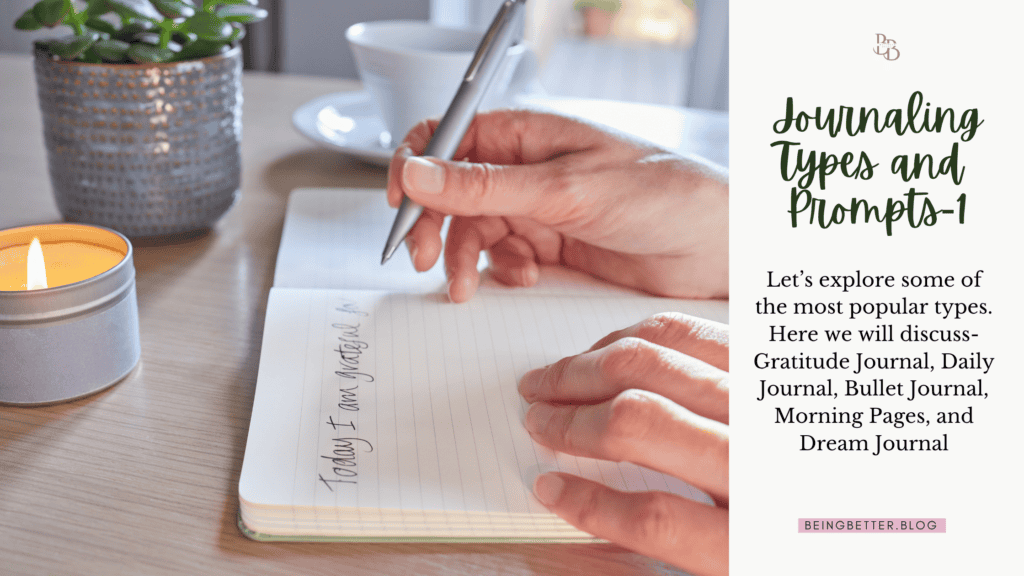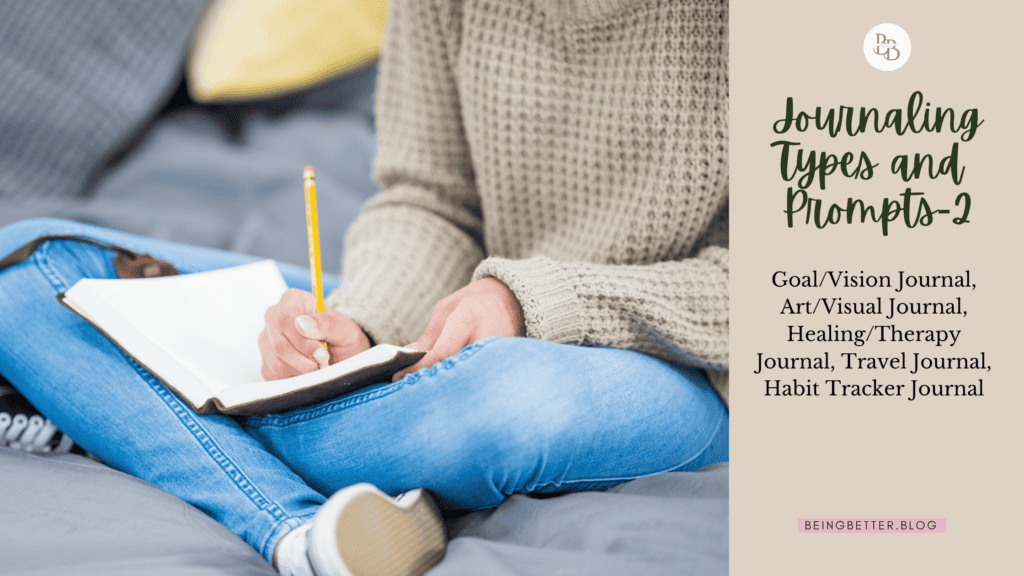Table of Contents
📝 Different Types of Journaling (Find Your Style!)
Journaling is more than just writing—it’s a gentle way to connect with yourself, process your thoughts, and grow in all areas of life. But here’s the beautiful part: there’s no one “right” way to journal. From gratitude and goal-setting to emotional healing and habit tracking, different types of journaling serve different needs—and you get to choose what fits your journey.
In this article, we’ll explore powerful types of journaling, how to start each one step by step, their benefits, and thoughtful prompts to help you begin—especially if you’re feeling stuck. Whether you’re craving peace, clarity, motivation, or creativity, there’s a journaling style here waiting for you.
Journaling has many styles to match your mood, purpose, and personality.
Let’s explore some of the most popular types. Here we will discuss- Gratitude Journal, Daily Journal, Bullet Journal, Morning Pages, and Dream Journal
1. Gratitude Journal
What Is a Gratitude Journal?
A gratitude journal is a personal space where you write down the things you’re thankful for—big or small, simple or special. It helps you notice and appreciate the good that already exists in your life. Think of it as a gentle reminder that even on hard days, there’s still something worth smiling about.
✍️ How to Start a Gratitude Journal: Step-by-Step Guide
1. Pick Your Journal Spot
Choose a notebook you love or open your notes app. You can even decorate your journal to make it feel more personal and inviting.
Tip: Keep it by your bedside or in your bag—somewhere easily accessible.
2. Set a Time (and Stick to It!)
The best time? Whenever you feel calm and reflective. Many people prefer mornings to set the tone for the day or evenings to unwind before sleep.
Try starting with just 5 minutes a day.
3. Begin With Just 3 Things
Write down three things you’re grateful for. They don’t have to be big or perfect. It could be a cup of tea, a kind smile from someone, or how you handled a tough situation today.
“I’m grateful for the sunshine on my face.”
“I’m thankful I had time to rest today.”
“I appreciate my body for carrying me through this day.”
4. Be Specific and Reflect
Instead of writing “I’m grateful for my family,” try writing,
“I’m grateful for the phone call with my sister that made me laugh so hard I forgot my stress.”
Specifics bring emotions to life and help your brain really feel the gratitude.
5. Feel It as You Write
Let your heart connect with your words. Close your eyes and relive that moment. The goal isn’t just to write—but to feel grateful.
6. Keep It Going—Even on Tough Days
Gratitude isn’t just for happy moments. On hard days, you can still be thankful for your strength, the lesson, or simply having made it through.
🌈 Benefits of Gratitude Journaling
Writing in a gratitude journal may seem small, but its impact can be powerful:
- 💛 Lifts your mood — Shifts your focus from what’s missing to what’s present.
- 🌿 Reduces stress and anxiety — Helps your brain calm down and reframe negative thoughts.
- 😌 Improves sleep — Reflecting on good things before bed brings emotional peace.
- 💪 Builds resilience — You start to see how much strength and beauty is in your everyday life.
- ❤️ Enhances relationships — You become more appreciative and present with the people around you.
- ✨ Boosts self-worth — You realize you do have a good life, even if it’s not perfect.
💬 Gratitude Journal Prompts (For When You Feel Stuck)
Sometimes we don’t know what to write. That’s okay! Here are some gentle and thoughtful prompts to help get you started:
Daily Simple Prompts:
- What made me smile today?
- A moment today I want to remember…
- Something small I often take for granted but I appreciate today is…
- One thing in nature I’m thankful for is…
- Someone I’m grateful for and why…
Deeper Reflection Prompts:
- What challenge have I faced recently that I’m thankful for (because of what it taught me)?
- How have I grown over the past year?
- A quality I love about myself is…
- What memory makes me feel deeply grateful every time I think of it?
- Who supported me when I needed it the most?
You don’t have to answer all of these. Pick one each day and let your heart do the rest.
2. Daily Journal: Your Everyday Mental Clean-Up
What Is a Daily Journal?
A daily journal is your personal space to write about anything that’s on your mind each day—your thoughts, feelings, to-dos, worries, dreams, small wins, or anything else you want to express. It’s like having a quiet conversation with yourself at the end (or beginning) of the day.
Unlike other journals with a specific theme, the daily journal is open-ended. That means you decide what goes in it. It can be messy, raw, joyful, boring, or brilliant. It’s all yours.
✍️ How to Start a Daily Journal: Step-by-Step
1. Choose Your Format
Pick whatever works best for you—a physical notebook, a digital journal app, or even voice notes if you don’t like writing.
Tip: Don’t overthink about having the “perfect” journal. Just start!
2. Pick the Right Time
Most people journal either:
- In the morning – to set intentions and clear mental clutter.
- At night – to process the day and release what’s on their mind.
Choose what fits your routine best—even five minutes can help.
3. Start With a Simple Entry Format
If you don’t know what to write, try this daily structure:
- Today I feel…
- What happened today?
- What’s on my mind right now?
- What do I want to remember from today?
- One small win today was…
You can always freestyle too. There are no rules.
4. Write Honestly (Not Perfectly)
Don’t worry about grammar, handwriting, or how your writing sounds. This is for you, not anyone else. Be raw, real, and unfiltered.
Even if you write “I don’t know what to write today,” that counts!
5. Make It a Ritual
Light a candle. Make a cup of tea. Sit by the window. Pair your journaling with something comforting so it becomes a calming, cozy habit.
🌱 Why Daily Journaling Is So Powerful
Writing every day might sound like a small thing, but it can totally change the way you see yourself and your life. Here’s why it’s worth it:
- 🧘♀️ Clears your mind — Helps unload mental noise and reduces overthinking.
- 💭 Builds self-awareness — You start understanding your patterns, emotions, and triggers.
- ✨ Improves focus and clarity — Writing brings structure to your thoughts.
- 📈 Tracks your growth — Over time, you’ll see how much you’ve changed and grown.
- ❤️ Boosts emotional balance — It gives you a safe place to feel, release, and reset.
- 🌤️ Helps with anxiety or stress — When you write it out, it often doesn’t feel as heavy anymore.
💡 Daily Journal Prompts to Get You Started
Quick & Light Prompts:
- What made me smile today?
- Something new I noticed about myself today…
- What am I looking forward to tomorrow?
- One thing I handled better than yesterday…
- What do I need more of in my life?
Deeper Prompts:
- What’s been weighing on my mind lately?
- Is there something I’m avoiding? Why?
- What lesson did today teach me?
- How am I really feeling today—and why?
- If today had a theme or message, what would it be?
You don’t need long answers—just be present and honest.
3. Bullet Journal: Organize Your Life, One Dot at a Time
A bullet journal (often called BuJo) is a customizable, creative journaling system that helps you organize your thoughts, track your goals, plan your days, and express your creativity—all in one notebook.
Created by Ryder Carroll, it uses short bullet points, symbols, and collections to keep everything in one place: your to-do lists, habits, moods, ideas, reflections, gratitude, and more.
It’s part planner, part journal, part tracker—and completely personal. You make it what you want it to be.
✍️ How to Start a Bullet Journal
Here’s a beginner-friendly process:
1. Choose Your Tools
All you need is:
- A notebook (dotted pages are most popular)
- A pen or pencil
Optional: Color pens, highlighters, washi tapes—if you enjoy decorating!
2. Create an Index Page
Leave the first 1–2 pages blank for an Index, where you’ll later write page numbers and topics. It helps you quickly find things in your journal.
Example:
Page 3 – Monthly Planner
Page 6 – Habit Tracker
Page 10 – Gratitude Log
3. Set Up Key Components
Here are the basic building blocks:
• Future Log
A year-at-a-glance view. Note down future appointments, goals, or birthdays.
• Monthly Log
Overview of the current month. Includes a calendar and to-do list.
• Daily Log
Daily entries to plan your day—appointments, tasks, reminders, moods, or thoughts.
• Collections
Custom pages for things like:
- Habit trackers
- Gratitude lists
- Meal plans
- Books to read
- Goals
- Mood trackers
Tip: Don’t try to do everything at once. Start with a few pages and grow from there.
4. Use Symbols (Bullets)
Here’s the magic: instead of writing full sentences, use symbols for quick clarity:
- • Task
- × Task completed
- → Task migrated
- ○ Event
- – Note or thought
You can create your own key too!
5. Customize It for You
Do you want to focus on mental health? Add a mood tracker. Want to build new habits? Add a habit tracker. Your bullet journal should reflect your life and needs.
This is your personal command center—make it fun, simple, or beautifully designed. You decide!
✅ Benefits of Bullet Journaling
Bullet journaling isn’t just for productivity—it’s a self-care tool too! Here’s why people love it:
- 🧠 Clears mental clutter — Everything has a place.
- ⏳ Saves time & energy — You’re more organized and intentional.
- 📆 Improves time management — Helps plan your day, week, month better.
- ✨ Boosts creativity — You can doodle, design, and make it truly yours.
- 💖 Supports emotional wellness — Combines journaling and tracking for personal growth.
- 🧘♀️ Builds mindfulness — Keeps you focused on what really matters.
🖊️ Bullet Journal Page Ideas (a.k.a. “Collections” You Can Try)
If you’re unsure what to include, here are some inspiring ideas to start with:
For Productivity:
- Daily & Weekly To-Do Lists
- Monthly Goals
- Priority Matrix
- Time-Blocking Layouts
For Wellness:
- Mood Tracker
- Sleep Tracker
- Gratitude Log
- Self-Care Ideas Page
For Creativity & Fun:
- Doodle Pages
- Favorite Quotes
- Vision Board Spread
- Monthly Reflection Page
For Personal Growth:
- Habit Tracker
- Affirmation List
- Mind Dump or Brain Dump Page
- “Things I’m Learning About Myself” Collection
💡 Journal Prompts for Bullet Journal (Optional but Powerful)
While bullet journals are more visual and structured, you can still include short reflections or prompts when you need clarity:
- What are my top 3 priorities this week?
- How did I feel today on a scale of 1–10?
- What small thing can I do tomorrow for my mental peace?
- What habits are helping me, and what’s draining me?
4. Stream of Consciousness / Morning Pages: Clear Your Mind, Free Your Soul
Stream of consciousness journaling (often called Morning Pages) is a raw, unfiltered writing practice where you let your thoughts pour onto the page exactly as they come—without editing, censoring, or worrying about grammar or structure.
This style became popular through Julia Cameron’s book The Artist’s Way, where she suggests writing three pages first thing in the morning. But you can do it anytime that suits your life.
It’s like giving your mind a deep clean—whatever’s stuck, circling, or heavy inside you finally gets a safe place to land.
✍️ How to Do Stream of Consciousness / Morning Pages: Step-by-Step Guide
1. Pick the Right Time
While morning is ideal (because your mind is quiet and uncluttered), you can also do this at night to release the day’s noise.
Tip: Do it before checking your phone or talking to anyone, if you choose mornings.
2. Grab a Notebook (and Keep It Private)
Choose a journal or notebook you won’t mind filling up quickly. This is just for you—no one else will read it. You don’t need to make it look pretty.
This helps you feel safe being totally honest and unfiltered.
3. Set a Timer or Page Goal
Write for:
- 3 full pages (handwritten)
or - 10–15 minutes straight (timed, especially if typing)
4. Start Writing—Without Thinking
Just begin. Even if your mind feels blank, write that:
“I don’t know what to write right now, but I’m just going to keep writing…”
Let your thoughts spill. It could be:
- Random thoughts
- Worries
- Emotions
- Ideas
- Dreams
- Frustrations
- Silly observations
Let it be messy. That’s the point.
5. No Editing or Judging
Don’t fix sentences, don’t go back, don’t overthink. This isn’t a blog post or essay—it’s your stream of consciousness. Let it be weird, emotional, scattered, repetitive. It’s all welcome.
🌿 Benefits of Stream of Consciousness / Morning Pages
This kind of journaling may feel strange at first, but with time it becomes deeply healing and eye-opening.
Here’s what it can do for you:
- 🧠 Clears mental clutter
- 💭 Unlocks creativity
- 😌 Reduces anxiety & overthinking
- 🧘♀️ Connects you with your true self
- ✨ Improves self-awareness
- ❤️ Deep emotional release
💡 Prompts to Ease Into Stream-of-Consciousness Writing (If You’re Stuck)
Even though the goal is free-flow writing, sometimes you need a gentle nudge to begin. Try these as openers:
- “Right now, I’m thinking about…”
- “I woke up feeling… and I don’t know why.”
- “What I really want to say is…”
- “I keep going back to this thought:”
- “This memory popped into my mind…”
- “Here’s everything I need to get off my chest right now…”
Just pick one and write without stopping. Let the rest unfold naturally.
5. Dream Journal: Unlock the Secrets of Your Sleeping Mind
What Is a Dream Journal?
A dream journal is a personal log where you write down your dreams as soon as you wake up—before they fade away. It’s a gentle and reflective way to explore your subconscious mind, emotions, hidden fears, and even creative ideas that show up while you sleep.
Your dreams might feel random or strange, but they often carry meaning, messages, or emotional clues that your conscious mind misses during the day.
Even if you think, “I don’t remember my dreams,”—don’t worry. With practice, a dream journal can actually train your brain to recall and reflect on them more easily.
✍️ How to Start a Dream Journal: Step-by-Step
Dream journaling is a beautiful morning ritual. Here’s how to make it part of your daily rhythm.
1. Keep Your Journal Near Your Bed
Place a notebook and pen (or use a dream journaling app) beside your bed. You want it within reach so you can write immediately after waking up.
Tip: Use a dim light or night lamp so you don’t jolt yourself fully awake and forget everything.
2. Write as Soon as You Wake Up
The moment your eyes open—even if it’s the middle of the night—write down everything you remember, even small fragments like feelings, colors, symbols, or emotions.
Try to note:
- What happened?
- Who was there?
- How did you feel?
- Any symbols or repeating themes?
3. Don’t Worry About Grammar or Logic
Dreams are often messy and weird. That’s okay. Don’t try to make sense of it while writing. Just get it all down. You can reflect later.
“I was flying, then I was in school, then everything turned green” — yes, write that.
4. Add a Reflection (Optional)
Once you’re fully awake, you can reread what you wrote and add a little note:
- “This dream reminded me of…”
- “I think this may be connected to…”
- “This made me feel…”
This can help you understand emotional patterns, anxieties, or desires that show up in dreams.
5. Be Consistent, Even If You Don’t Remember Anything
Write something every morning—even if it’s:
“I don’t remember any dream today.”
Over time, your brain will get the message that dreams are important, and you’ll start remembering more.
🌠 Benefits of Keeping a Dream Journal
Dreams aren’t just random—they can be surprisingly meaningful. Here’s why a dream journal is worth your time:
- 🌌 Improves dream recall — The more you record, the more you remember.
- 🔍 Helps with self-discovery — Dreams often reflect your emotions, struggles, or needs.
- 🧠 Taps into creativity — Many artists, writers, and inventors use dream journaling for inspiration.
- 💭 Processes unresolved feelings — Dreams help your brain sort through emotions; journaling lets you process them consciously.
- 🌙 Supports lucid dreaming — If you’re curious about becoming aware while dreaming, a dream journal is the first step.
💡 Dream Journal Prompts to Help You Begin (Especially If You’re Struggling)
Some mornings your mind might feel blank, or your dreams may seem too weird to explain. Try starting with these:
- What’s the strongest image or feeling I remember from my dream?
- Did anything or anyone from real life show up?
- How did the dream make me feel—during and after?
- Was there a repeating theme, symbol, or location?
- What might this dream be trying to show me?



